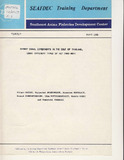| dc.description.abstract | Since the introduction of otter-board trawl in 1961, there has been a rapid development of fishery production in Thailand. The excessive use of otter-board trawl has, however, resulted in over-fishing and depletion of demersal resources especially in coastal areas of Gulf of Thailand, where the catch of a day’s trawling may contain as many as 100 species or more, including a large number of shrimp species. This shows that, in such multispecies trawl fisheries, incidental catch may lead to depletion of non-target species. For example, shrimp trawl fishery, which is generally operated in coastal areas with small-sized baby trawlers less than 14 m in length, has been accused of killing significant numbers of juvenitles /young of economical important fish species.
The depletion of demersal resources may be caused by increased fishing intensity in terms of fishing effort (which includes improved net design, smaller mesh size and adjustment of the operation system both in space and time for better catches etc.). In such a situation, fishing control measures should be considered with regard to trawl fishery. It has also become necessary to investigate the effects of shrimp trawl nets on incidental catches, with a view to preventing the capture of juveniles or young of economically important species.
The SEAFDEC Training Department therefore initiated shrimp trawl experiments. The planning of these experiments was done by Mr. T. Yamazaki, one of the authors of this report. The experiments themselves were carried out by other Department staff as member of the survey team, and the present report was compiled by Dr. S. Hayase, member of the Research Division of the Training Department, SEAFDEC.
In this study, experimental shrimp trawls by different types of net have been attempted to establish the catch composition by animal groups in different fishing areas. Very little catch composition by different nets is available for the evaluation of the catching efficiency for shrimp. Furthermore, there is a lack of information on the reaction of marine animals. For example, the behavior of marine animals in response to net operations cannot yet be definitely established. Therefore the present study is limited to an estimation of catch selectivity by different types of net. | en |

